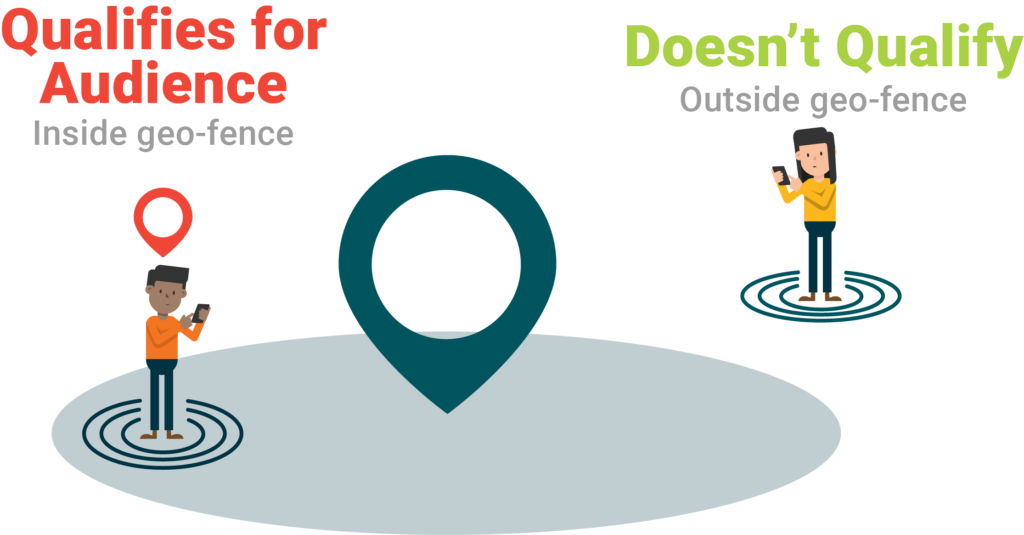To geo-fence or not to geo-fence? That is the question.

One of the most frequent questions we’ve been asked over the last 5 years is about running a geo-fencing ad campaign. 95% of the time when people make this ask, it’s because someone just got out of a sales pitch or heard it mentioned in a marketing podcast. The answer is yes, we can run one for you! However, as your marketing partner we want to be good stewards of your dollars and will ask you several questions before we recommend it. The reality is that geo-fencing is a targeting tactic. It has to be used the right way to have a positive impact and make the investment worthwhile.
How do you know if a geo-fencing campaign is right for you? Think through your answers to the questions below.
what size is your audience pool?
One of the first questions we’ll ask is about the size of your audience. Whether it’s many people over a long period of time or a large crowd during or following a particular event, we have to have an audience of scale to make this work.
what’s your prospective customer’s mindset like when they’re in the proposed geo-fenced zone?
Getting the right message and timing in front of your prospect is key. Think through the way your prospective customer will be seeing and engaging with your ads. Is the timing going to be right? Is the message going to be right? If your widget is the type that has to be purchased repeatedly – like toilet paper – then maybe putting the right message (“Next time get your TP cheaper!” Or something similar) in front of your prospects after they’ve made a purchase could make a lot of sense.
where are they at in their buying cycle?
You may be thinking, does digital still make sense given these privacy updates? The short answer is yes, however, there are some adjustments to be made in order to maximize your strategies. Many people are interested in geo-fencing their competitors. In some instances this can work really well, or in others it can be an epic waste of money. For instance, if you’re selling a widget that people can easily research online and mostly only come to your brick and mortar location to make a purchase, the same is typically true when they go to your competitor. That means your geo-fenced campaign is most likely going to hit prospective customers after they’ve already made a purchase from your competitor. An exception to this is reaching prospects who went to your competitor’s brick and mortar and did not make a purchase or when they are likely to buy repeatedly over time. In those instances geofencing with retargeting ads gives you the opportunity to get back in front of your prospect ahead of your competition.
How do I use events to my advantage?
One of the most common examples of geo-fencing success stories you’ll hear is marketing to event attendees during events and retargeting to them after the fact. Again, with the right audience size, message, timing, and product, this can be highly effective. For instance, marketing your restaurant to concert goers or retargeting event visitors to come back to repeat events. These can be especially successful if you include an offer in your ad such as, “Come to Mario’s pizza tonight after the show. Mention this ad to get 20% off your favorite pie!” Where this wouldn’t work so well is, for instance, geo-fencing the superbowl with a local service because your hometown team is competing. The big game is held in a neutral location and you’d be serving your local ads to spectators from all over the country who would be unlikely to do business with you.
What other targeting tactics are you running for the campaign?
If the answer is none and you’re putting all your eggs in the geo-fencing basket, we’re unlikely to recommend it. Yes, geo-fencing can help you get in front of the right folks, but its position in the buying funnel varies and is pretty unique. It is best to consider geo-fencing as a strategy above and beyond a well-rounded marketing campaign designed to reach consumers wherever they are in the physical world or the sales funnel. With such tight targeting parameters and specific use cases, geo-fencing is best when paired with other digital and traditional ad buys.
In the right place, time, and with the right widget, geo-fencing can make a lot of sense as a complement to your other marketing strategies. We encourage you to think through your prospective customer, where they’re at in the buying cycle, and whether a geo-fencing campaign would inspire action if you were in their shoes.
Go forth. Go Digital.
-cohort.crew



